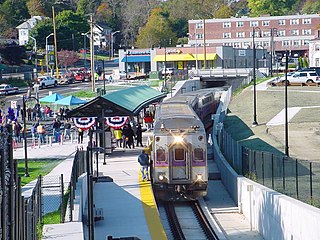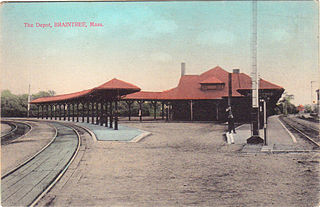
Braintree, officially the Town of Braintree, is a municipality in Norfolk County, Massachusetts, United States. Although officially known as a town, Braintree is a city, with a mayor-council form of government, and is considered a city under Massachusetts law. The population was 39,143 at the 2020 census. The city is part of the Greater Boston area with access to the MBTA Red Line, and is a member of the Metropolitan Area Planning Council's South Shore Coalition. The first mayor of Braintree was Joe Sullivan who served until January 2020. The current mayor of Braintree is Charles Kokoros.

JFK/UMass station is a Massachusetts Bay Transportation Authority (MBTA) intermodal transfer station, located adjacent to the Columbia Point area of Dorchester, Boston, Massachusetts. It is served by the rapid transit Red Line; the Greenbush Line, Kingston/Plymouth Line, and Middleborough/Lakeville Line of the MBTA Commuter Rail system, and three MBTA bus routes. The station is named for the John F. Kennedy Presidential Library and Museum and the University of Massachusetts Boston, both located nearby on Columbia Point.

The MBTA Commuter Rail system serves as the commuter rail arm of the Massachusetts Bay Transportation Authority's (MBTA's) transportation coverage of Greater Boston in the United States. Trains run over 394 mi (634 km) of track to 134 stations. It is operated under contract by Keolis, which took over operations on July 1, 2014, from the Massachusetts Bay Commuter Railroad Company (MBCR).

Bethlehem Steel Corporation Shipbuilding Division was created in 1905 when the Bethlehem Steel Corporation of Bethlehem, Pennsylvania, acquired the San Francisco shipyard Union Iron Works. In 1917 it was incorporated as Bethlehem Shipbuilding Corporation, Limited.

Fore River Shipyard was a shipyard owned by General Dynamics Corporation located on Weymouth Fore River in Braintree and Quincy, Massachusetts. It began operations in 1883 in Braintree, and moved to its final location on Quincy Point in 1901. In 1913, it was purchased by Bethlehem Steel, and later transferred to Bethlehem Shipbuilding Corporation. It was sold to General Dynamics in 1963, and closed in 1986. During its operation, yardworkers constructed hundreds of ships, for both military and civilian clients.

The Old Colony Railroad (OC) was a major railroad system, mainly covering southeastern Massachusetts and parts of Rhode Island, which operated from 1845 to 1893. Old Colony trains ran from Boston to points such as Plymouth, Fall River, New Bedford, Newport, Providence, Fitchburg, Lowell and Cape Cod. For many years the Old Colony Railroad Company also operated steamboat and ferry lines, including those of the Fall River Line with express train service from Boston to its wharf in Fall River where passengers boarded luxury liners to New York City. The company also briefly operated a railroad line on Martha's Vineyard, as well as the freight-only Union Freight Railroad in Boston. The OC was named after the "Old Colony", the nickname for the Plymouth Colony.

Braintree station is an intermodal transit station in Braintree, Massachusetts. It serves the MBTA's Red Line and the MBTA Commuter Rail Old Colony Lines as well as MBTA buses.

Quincy Adams station is a rapid transit station in Quincy, Massachusetts. It serves the Braintree Branch of the MBTA's Red Line. Located in southern Quincy on Burgin Parkway near the Braintree Split, the station features a large park and ride garage, with space for 2,538 automobiles, built over the station tracks and platforms. It is fully accessible.

Quincy Center station is an intermodal transit station in Quincy, Massachusetts. It is a transfer station between the MBTA Red Line subway, MBTA Commuter Rail's Old Colony Lines and Greenbush Line, and a number of MBTA bus routes. It is located between Hancock Street and Burgin Parkway in the Quincy Center district. Opened in 1971, the station was covered by a large parking garage which was closed in 2012 due to structural problems. A project to remove and replace the garage is under way.

North Quincy station is an MBTA subway Red Line station in Quincy, Massachusetts. It is located in North Quincy, off Hancock Street. A major park-and-ride stop, it has over 1200 parking spaces for commuters. It also serves as a minor bus terminal, with five MBTA bus routes stopping at the south end of the station. The station is fully accessible.

The Connecticut Southern Railroad is a 90-mile (140 km) long short-line railroad operating in Connecticut and Massachusetts. The company was formed in 1996 as a spinoff of Conrail by shortline holding company RailTex and subsequently acquired in 2000 by RailAmerica. Since 2012, it has been a subsidiary of Genesee & Wyoming. CSO is headquartered in Hartford, Connecticut, site of its Hartford Yard. The company also operates East Hartford Yard.

Wollaston station is a rapid transit station in Quincy, Massachusetts. Located in the Wollaston neighborhood, it serves the MBTA's Red Line. It was opened in September 1971 as the second of three stations in the original South Shore Extension, replacing a mainline rail station which had been located there from 1845 to 1959. Wollaston station was closed from January 8, 2018, to August 16, 2019, for renovations to the station, including flood mitigation and accessibility improvements.

The Greenbush Line is a branch of the MBTA Commuter Rail system which serves the South Shore region of Massachusetts. The 27.6-mile (44.4 km) line runs from downtown Boston, Massachusetts through the cities and towns of Quincy, Weymouth, Hingham, Cohasset, and Scituate to the Greenbush neighbourhood in southern Scituate. There are ten stations along the line. From South Station, to Quincy Center, service operates in conjunction with the Old Colony Lines commuter rail service via the Old Colony Main Line. From Weymouth Landing/East Braintree to Greenbush, trains utilize the Greenbush Branch, the former South Shore Railroad line that was later incorporated into the Old Colony Railroad.

The Old Colony Lines are a pair of branches of the MBTA Commuter Rail system, connecting downtown Boston, Massachusetts with the South Shore and cranberry-farming country to the south and southeast. The two branches operate concurrently for 10 miles (16 km) via the Old Colony Mainline from South Station to Braintree station. The Middleborough/Lakeville Line then winds south through Holbrook, Brockton, Bridgewater, Middleborough, and Lakeville via the Middleborough Main Line and Cape Main Line. The Kingston Line heads southeast to serve Weymouth, Abington, Whitman, Hanson, Halifax, and Kingston by way of the Plymouth branch. Limited service to Plymouth was provided prior to April 2021 but was cut due to low ridership and budget constraints.

Weymouth Fore River is a small bay or estuary in eastern Massachusetts and is part of the Massachusetts Bay watershed.

Weymouth Landing/East Braintree station is an MBTA Commuter Rail station on the border of Braintree and Weymouth, Massachusetts. It serves the Greenbush Line. It is located in Weymouth Landing, and consists of a single side platform serving the line's one track. The station is fully accessible.
The following is a brief history of the North American rail system, mainly through major changes to Class I railroads, the largest class by operating revenue.
The Dighton and Somerset Railroad, currently referred to as the Dean Street Industrial Track, is a railroad that ran between Fall River and Braintree, Massachusetts. It opened in 1866; from the 1890s to the 1930s and again in the late 1950s, it was the primary rail route from Boston to the South Coast. Passenger service ended in stages with the final regular service in 1958, though freight service on two short segments continues into the 21st century. MBTA Commuter Rail service is proposed to be extended onto the northern part of the line around 2030 as part of the South Coast Rail project.

The South Shore Railroad was a railroad in Massachusetts. It was incorporated in 1846 to provide rail service between Quincy and Duxbury, Massachusetts through the towns of Hingham, Cohasset, Scituate and Marshfield.

The Lehigh Line is a railroad line in central New Jersey, Northeastern Pennsylvania, and the Lehigh Valley region of eastern Pennsylvania. It is owned and operated by the Norfolk Southern Railway. The line runs west from the vicinity of the Port of New York and New Jersey via Conrail's Lehigh Line to the Susquehanna River valley at the south end of the Wyoming Valley Coal Region. Administratively, it is part of Norfolk Southern's Keystone Division and is part of the Crescent Corridor. As of 2021 the line is freight-only, although there are perennial proposals to restore passenger service over all or part of the line.




















